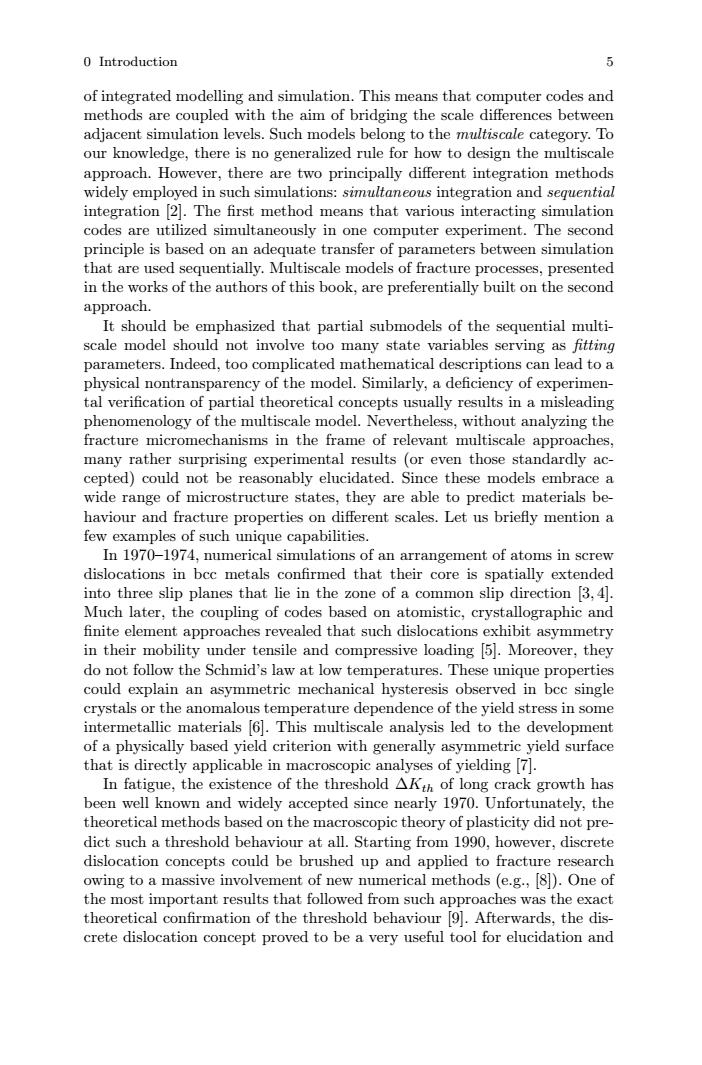正在加载图片...

0 Introduction 分 of integrated modelling and simulation.This means that computer codes and methods are coupled with the aim of bridging the scale differences between adjacent simulation levels.Such models belong to the multiscale category.To our knowledge,there is no generalized rule for how to design the multiscale approach.However,there are two principally different integration methods widely employed in such simulations:simultaneous integration and sequential integration [2].The first method means that various interacting simulation codes are utilized simultaneously in one computer experiment.The second principle is based on an adequate transfer of parameters between simulation that are used sequentially.Multiscale models of fracture processes,presented in the works of the authors of this book,are preferentially built on the second approach. It should be emphasized that partial submodels of the sequential multi- scale model should not involve too many state variables serving as fitting parameters.Indeed,too complicated mathematical descriptions can lead to a physical nontransparency of the model.Similarly,a deficiency of experimen- tal verification of partial theoretical concepts usually results in a misleading phenomenology of the multiscale model.Nevertheless,without analyzing the fracture micromechanisms in the frame of relevant multiscale approaches, many rather surprising experimental results (or even those standardly ac- cepted)could not be reasonably elucidated.Since these models embrace a wide range of microstructure states,they are able to predict materials be- haviour and fracture properties on different scales.Let us briefly mention a few examples of such unique capabilities. In 1970-1974,numerical simulations of an arrangement of atoms in screw dislocations in bcc metals confirmed that their core is spatially extended into three slip planes that lie in the zone of a common slip direction [3,4]. Much later,the coupling of codes based on atomistic,crystallographic and finite element approaches revealed that such dislocations exhibit asymmetry in their mobility under tensile and compressive loading 5.Moreover,they do not follow the Schmid's law at low temperatures.These unique properties could explain an asymmetric mechanical hysteresis observed in bcc single crystals or the anomalous temperature dependence of the yield stress in some intermetallic materials 6.This multiscale analysis led to the development of a physically based yield criterion with generally asymmetric yield surface that is directly applicable in macroscopic analyses of yielding [7]. In fatigue,the existence of the threshold AKth of long crack growth has been well known and widely accepted since nearly 1970.Unfortunately,the theoretical methods based on the macroscopic theory of plasticity did not pre- dict such a threshold behaviour at all.Starting from 1990,however,discrete dislocation concepts could be brushed up and applied to fracture research owing to a massive involvement of new numerical methods(e.g.,[8).One of the most important results that followed from such approaches was the exact theoretical confirmation of the threshold behaviour 9.Afterwards,the dis- crete dislocation concept proved to be a very useful tool for elucidation and0 Introduction 5 of integrated modelling and simulation. This means that computer codes and methods are coupled with the aim of bridging the scale differences between adjacent simulation levels. Such models belong to the multiscale category. To our knowledge, there is no generalized rule for how to design the multiscale approach. However, there are two principally different integration methods widely employed in such simulations: simultaneous integration and sequential integration [2]. The first method means that various interacting simulation codes are utilized simultaneously in one computer experiment. The second principle is based on an adequate transfer of parameters between simulation that are used sequentially. Multiscale models of fracture processes, presented in the works of the authors of this book, are preferentially built on the second approach. It should be emphasized that partial submodels of the sequential multiscale model should not involve too many state variables serving as fitting parameters. Indeed, too complicated mathematical descriptions can lead to a physical nontransparency of the model. Similarly, a deficiency of experimental verification of partial theoretical concepts usually results in a misleading phenomenology of the multiscale model. Nevertheless, without analyzing the fracture micromechanisms in the frame of relevant multiscale approaches, many rather surprising experimental results (or even those standardly accepted) could not be reasonably elucidated. Since these models embrace a wide range of microstructure states, they are able to predict materials behaviour and fracture properties on different scales. Let us briefly mention a few examples of such unique capabilities. In 1970–1974, numerical simulations of an arrangement of atoms in screw dislocations in bcc metals confirmed that their core is spatially extended into three slip planes that lie in the zone of a common slip direction [3, 4]. Much later, the coupling of codes based on atomistic, crystallographic and finite element approaches revealed that such dislocations exhibit asymmetry in their mobility under tensile and compressive loading [5]. Moreover, they do not follow the Schmid’s law at low temperatures. These unique properties could explain an asymmetric mechanical hysteresis observed in bcc single crystals or the anomalous temperature dependence of the yield stress in some intermetallic materials [6]. This multiscale analysis led to the development of a physically based yield criterion with generally asymmetric yield surface that is directly applicable in macroscopic analyses of yielding [7]. In fatigue, the existence of the threshold ΔKth of long crack growth has been well known and widely accepted since nearly 1970. Unfortunately, the theoretical methods based on the macroscopic theory of plasticity did not predict such a threshold behaviour at all. Starting from 1990, however, discrete dislocation concepts could be brushed up and applied to fracture research owing to a massive involvement of new numerical methods (e.g., [8]). One of the most important results that followed from such approaches was the exact theoretical confirmation of the threshold behaviour [9]. Afterwards, the discrete dislocation concept proved to be a very useful tool for elucidation and